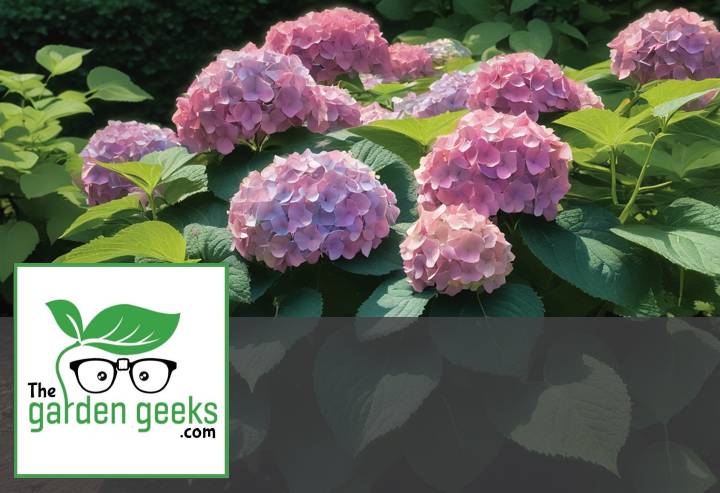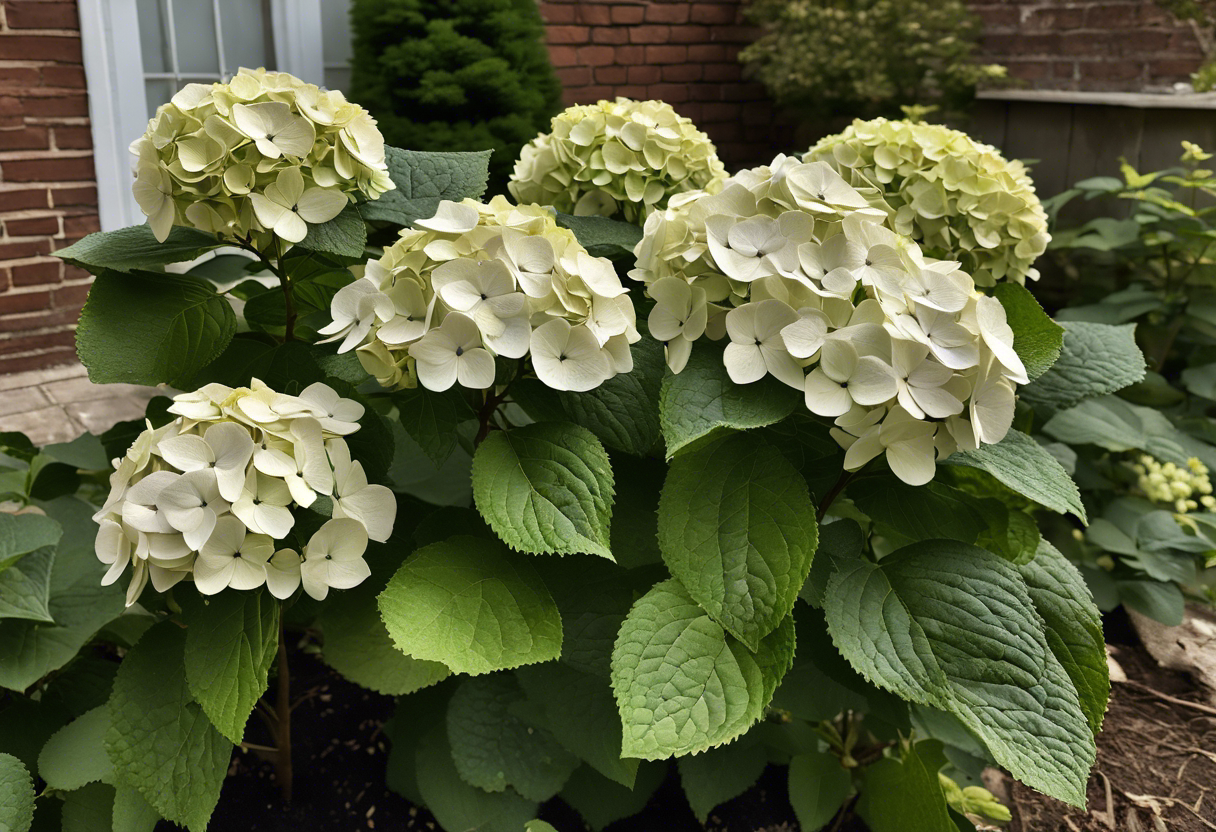Ever looked at your garden and wondered, “Why Your Hydrangea Isn’t Flowering?” You’re not alone. This perennial beauty can be a bit of a diva, demanding just the right conditions to strut its stuff. But don’t worry, we’ve got you covered with the lowdown on what could be going wrong.
In this post, we’ll dive into six reasons why your hydrangea might be giving you the silent treatment. From lack of sunlight to incorrect pruning, soil pH imbalance to nutrient deficiency – we’ll explore these issues in depth so that next season, your hydrangeas will be the talk of the neighborhood! So grab a cuppa and keep reading about (6 Reasons) Why Your Hydrangea Isn’t Flowering.
Key Takeaways
- Hydrangeas may not flower due to insufficient sunlight; they need at least 4 hours of sun daily.
- Over-fertilization can lead to lush foliage but no blooms.
- Improper pruning could remove the buds that would become flowers.
- Planting in a location with harsh winter conditions can kill flower buds.
- Hydrangeas require well-drained soil; waterlogged conditions can prevent flowering.
- Some varieties of hydrangeas have specific pH requirements for optimal blooming.
Insufficient Light: A Major Culprit
Ever wondered why your hydrangea isn’t flowering? Well, it could be due to insufficient light. Hydrangeas are sun-loving plants and inadequate sunlight can seriously hamper their flowering ability. Let’s delve into the hydrangea light needs and how light deprivation effects can impact their blooming.
Understanding Hydrangea’s Light Requirements
Hydrangeas love the sun, but not too much of it. They thrive in areas with morning sun and afternoon shade. This balance is crucial for optimal growth and flowering.
The ideal hydrangea sunlight requirement is about 4-6 hours of dappled or filtered sunlight per day. Too much direct sunlight can scorch the leaves, while too little can lead to sparse blooms.
Remember, each variety has its own specific light requirements. So, when planning your garden, consider these optimal light conditions as part of your hydrangea care tips.
Signs of Light Deprivation in Hydrangeas
If your hydrangea isn’t blooming, it might be screaming for more sunlight! One common sign of light deprivation in hydrangeas is a lush green plant with few or no flowers.
Another symptom could be elongated stems reaching out for light. This condition known as etiolation often results from insufficient light exposure.
So if you notice these signs, it’s time to reconsider your plant’s location or lighting conditions. Remember, understanding these symptoms can help you prevent a situation where there’s a non-flowering due to insufficient light.
Inappropriate Pruning
Ever wondered why your Hydrangea isn’t flowering? Well, it might be due to those pruning shears in your hand. Yes, you heard it right! Inappropriate or excessive pruning can be a major culprit behind your hydrangea bloom issues.
The Impact of Pruning on Flowering
Hydrangeas have a unique flowering cycle and growth pattern. They set their bloom buds for the next year during the summer and fall. So, if you’re overzealous with those shears, you might be cutting off future blooms without even realizing it. This is one of the common hydrangea pruning mistakes that leads to a drastic pruning impact on blooms.
The effects of bad pruning can be quite disheartening, especially when you’ve been waiting all year for those beautiful flowers. It’s not just about the quantity either – improper hydrangea care can also affect the quality of your blooms. Over-pruning can lead to weak, sparse flowers instead of the lush, full clusters we all love.
Correct Pruning Techniques for Hydrangeas
Now that we’ve established how important correct pruning is for your hydrangeas’ health and flower production, let’s talk about how to do it right. Different types of hydrangeas have different pruning needs – some need heavy cuts while others prefer light trims.
The best time to prune hydrangeas usually depends on their type and blooming time. For instance, bigleaf hydrangeas should ideally be pruned after they finish blooming in summer while panicle hydrangeas are best pruned in late winter or early spring.
Remember, promoting healthy growth through correct pruning is key to encouraging those abundant hydrangea blooms we all adore so much. So next time you reach for those shears, make sure you’re doing it at the right time and in the right way!
Wrong Soil pH
Wondering why your hydrangea isn’t flowering? Well, it could be due to the wrong soil pH. Hydrangeas are pretty picky about their soil conditions, and if the pH is off, they might just refuse to bloom. So, let’s dive into the importance of soil pH for these beauties.
Ideal Soil pH for Hydrangeas
Hydrangeas love a slightly acidic environment. The optimal hydrangea soil pH is between 5.0 and 6.0. This range allows them to absorb essential nutrients effectively, promoting healthy growth and abundant blooms.
Now you might be thinking, “Why such a specific range?” Well, it’s all about the chemistry! Certain nutrients that hydrangeas need can only be absorbed at this level of acidity. If the soil is too alkaline or too acidic, it can lock away these nutrients making them unavailable for your plant.
So remember folks, maintaining the importance of correct soil pH is key for your hydrangea’s happiness!
How to Test and Adjust Soil pH
Testing your garden’s acidity level isn’t as complicated as it sounds. You can get a simple soil testing kit from any garden center or online store.
Just follow the instructions on the package (usually involves taking a small sample of your garden soil), wait for the results and voila! You’ve got your answer.
If you find out that your garden is more ‘pH-unky’ than ‘pH-abulous’ (meaning it’s outside our ideal 5.0-6.0 range), don’t panic! There are ways to adjust it.
For instance, adding lime will raise an overly acidic soil’s pH while sulfur or aluminum sulfate can lower an overly alkaline one’s levels.
Remember though – moderation is key here! Too much of either can swing the pH too far in the other direction. So, take it slow and steady, and your hydrangeas will thank you for it!
4. Lack of Nutrients
If you’re wondering why your hydrangea isn’t flowering, a lack of essential nutrients might be the culprit. Like us, plants need their vitamins too! Hydrangeas are no exception.
4.1 Essential Nutrients for Hydrangea Growth
Hydrangeas require a balanced diet to thrive and bloom beautifully. The main course includes nitrogen, phosphorus, and potassium – the holy trinity of plant nutrition.
Nitrogen for hydrangeas is like protein for us; it’s crucial for leafy growth and overall vigor. Phosphorus plays a starring role in root development and blooming, so if your hydrangea is not flowering due to lack of nutrients, phosphorus might be the missing piece.
Potassium is the unsung hero that supports overall plant health and disease resistance. And let’s not forget about micronutrients like iron, zinc, and manganese – these little guys are vital for hydrangea health too!
4.2 Identifying Nutrient Deficiencies in Hydrangeas
Now, how do you know if your hydrangea is nutrient-starved? Well, they do give off signs. Yellow leaves on hydrangeas can indicate a nitrogen deficiency while stunted growth may point to a lack of phosphorus.
If you notice poor resistance to diseases or pests, it could mean there’s not enough potassium in your soil. Spotting nutrient deficiencies can be tricky but knowing what to look out for makes it easier.
Remember folks, a well-fed hydrangea is a happy one that rewards with bountiful blooms! So keep an eye out for those tell-tale signs of nutrient deficiency in hydrangeas and ensure they get their daily dose of essential nutrients.
Cold Damage
If you’re wondering why your hydrangea isn’t flowering, one culprit could be the cold. Frosty mornings and freezing nights can wreak havoc on your hydrangeas, causing what we call hydrangea cold damage.
Effects of Cold Weather on Hydrangea Blooming
When Jack Frost comes knocking, your hydrangeas might stop rocking. The cold weather impact on hydrangeas can be quite severe, disrupting the blooming process and leading to a lackluster display.
Freezing temperatures can cause the buds to wither before they even have a chance to bloom. This is known as freezing temperatures and hydrangea bloom disruption. It’s like being invited to a party but never making it through the front door because you slipped on some ice in the driveway.
Over time, repeated exposure to cold weather can lead to long-term damage, including cold-induced flower loss in hydrangeas. It’s like your plant gets so used to being cold that it forgets how to produce flowers altogether! Talk about a winter blues effect on hydrangea flowers!
Protecting Hydrangeas from Frost and Freeze
But don’t despair! There are ways of protecting hydrangeas from frost and freeze damage. One simple method is using frost cloths or blankets when frosty nights are forecasted. These act like cozy winter coats for your plants, keeping them warm despite the chill.
In addition to preventative measures, there are also steps you can take after a freeze has occurred. This is what we call post-freeze care for hydrangeas. If you notice any damaged or dead parts of the plant after a freeze event, prune these away promptly.
Remember, just like us humans need extra TLC in winter (think hot cocoa and fluffy socks), so do our plants! Providing proper winter protection for hydrangea plants can help ensure they bounce back in full bloom when spring arrives.
Plant Age or Maturity
If you’re wondering why your hydrangea isn’t flowering, it might just be a matter of hydrangea maturity. Just like humans, plants have their own lifecycle and growth stages. And yes, age does matter when it comes to the flowering process.
Understanding the Blooming Cycle of Hydrangeas
The blooming cycle of hydrangeas is a fascinating dance between the plant and Mother Nature. It’s all about timing and understanding this can give you some serious gardening knowledge.
Hydrangeas typically bloom in late spring to early summer, but this can vary depending on the variety and local climate conditions. So if you’re eagerly waiting for those stunning hydrangea flowers, remember to consider the plant’s natural lifecycle and manage your flower anticipation accordingly.
Patience with Young or Newly Transplanted Hydrangeas
Now let’s talk about young’uns – those adorable baby hydrangeas or newly transplanted ones. They might test your gardening patience as they may not burst into blooms right away.
This is perfectly normal, folks! These youngsters are busy focusing on root development and overall plant adaptation. It’s like they’re saying, “Hold on there, we’re working on our foundation first!”
So if you’ve been fretting over your young hydrangeas’ delayed flowering, take a chill pill! Give them time to settle in their new home before expecting them to throw a flower party. After all, good things come to those who wait!
To Wrap Up
Well, there you have it folks! We’ve dug deep into the gardening world to uncover the mysteries of Why Your Hydrangea Isn’t Flowering. It’s like being a plant detective, isn’t it?
Remember, your hydrangeas are picky eaters and light lovers, so treat them like the divas they are! Happy gardening!





